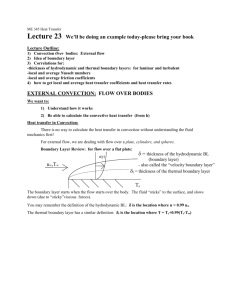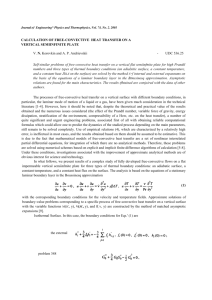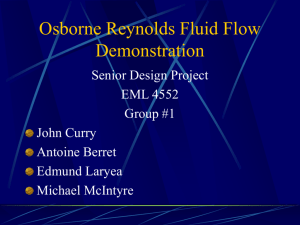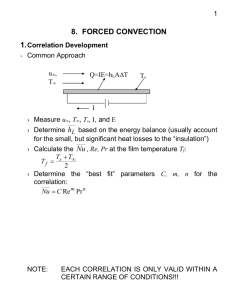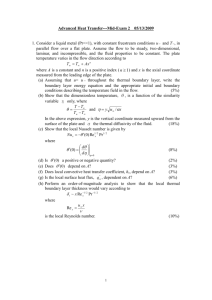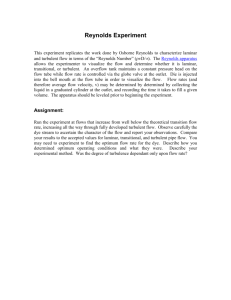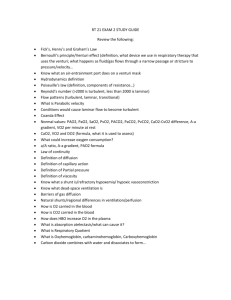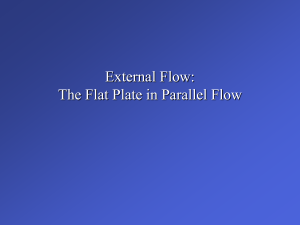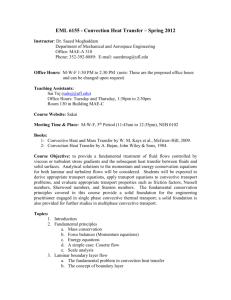External Flow: The Flat Plate in Parallel Flow
advertisement
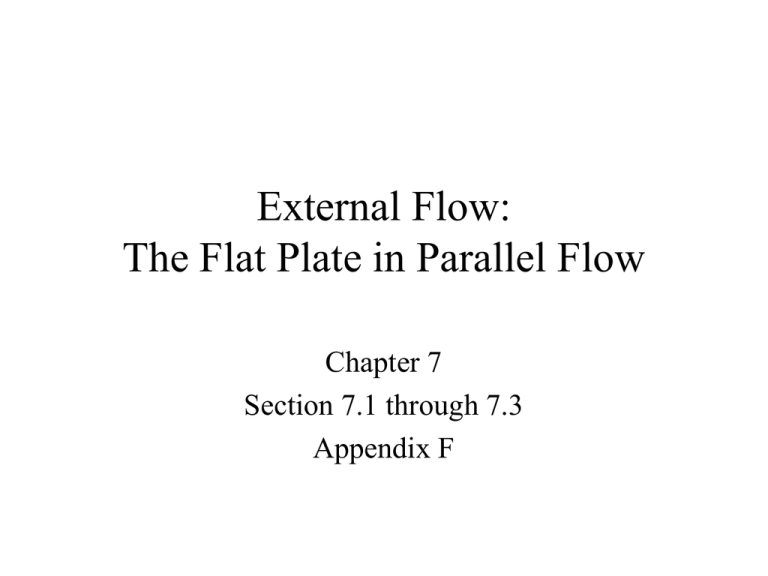
External Flow: The Flat Plate in Parallel Flow Chapter 7 Section 7.1 through 7.3 Appendix F Physical Features Physical Features • As with all external flows, the boundary layers develop freely without constraint. • Boundary layer conditions may be entirely laminar, laminar and turbulent, or entirely turbulent. • To determine the conditions, compute Re L u L u L and compare with the critical Reynolds number for transition to turbulence, Re x , c . Re L Re x , c laminar flow throughout Re L Re x , c transition to turbulent flow at xc / L Re x , c / Re L Physical Features (cont.) • Value of Re x , c depends on free stream turbulence and surface roughness. Nominally, Re x , c 5 105. • If boundary layer is tripped at the leading edge Re x , c 0 and the flow is turbulent throughout. • Surface thermal conditions are commonly idealized as being of uniform temperature Ts or uniform heat flux qs . Is it possible for a surface to be concurrently characterized by uniform temperature and uniform heat flux? • Thermal boundary layer development may be delayed by an unheated starting length. Equivalent surface and free stream temperatures for x and uniform Ts (or qs ) for x . Similarity Solution Similarity Solution for Laminar, Constant-Property Flow over an Isothermal Plate • Based on premise that the dimensionless x-velocity component, u / u , and temperature, T * T Ts / T Ts , can be represented exclusively in terms of a dimensionless similarity parameter y u / x 1/ 2 • Similarity permits transformation of the partial differential equations associated with the transfer of x-momentum and thermal energy to ordinary differential equations of the form d3 f d2 f 2 3f 0 d d 2 where u / u df / d , and d 2T * Pr dT * f 0 2 d 2 d Similarity Solution (cont.) • Subject to prescribed boundary conditions, numerical solutions to the momentum and energy equations yield the following results for important local boundary layer parameters: - with u / u 0.99 at 5.0, 5.0 u / vx 1/ 2 u - with s y 5x Re1/x 2 u y 0 and d 2 f / d 2 C f ,x 0 d2 f u / vx d 2 0.332, s, x 1/ 2 0.664Re x u2 / 2 - with hx qs / Ts T k T * / y and dT * / d and 0 Nu x 0 k u / vx 1/ 2 y 0 0.332 Pr1/ 3 for Pr 0.6, hx x 0.332 Re1/x 2 Pr1/ 3 k Pr1/ 3 t dT * / d 0 Similarity Solution (cont.) • How would you characterize relative laminar velocity and thermal boundary layer growth for a gas? An oil? A liquid metal? • How do the local shear stress and convection coefficient vary with distance from the leading edge? • Average Boundary Layer Parameters: 1 x 1.328 Re x1/ 2 s , x 0x s dx Cf , x hx 1 x hx dx x 0 Nu x 0.664 Re1/x 2 Pr1/ 3 • The effect of variable properties may be considered by evaluating all properties at the film temperature. Tf Ts T 2 Turbulent Flow Turbulent Flow • Local Parameters: Empirical Correlations C f , x 0.0592 Rex 1/ 5 Nu x 0.0296 Re4x / 5 Pr1/ 3 How do variations of the local shear stress and convection coefficient with distance from the leading edge for turbulent flow differ from those for laminar flow? • Average Parameters: 1 xc L hL 0 h1am dx xc hturb dx L Substituting expressions for the local coefficients and assuming Re x ,c 5 105 , 0.074 1742 C f , L 1/ 5 Re L Re L Nu L 0.037 Re4L / 5 871 Pr1/ 3 For Re x , c 0 or L xc Re L Re x ,c , C f , L 0.074 Re L1/ 5 Nu L 0.037 Re 4L / 5 Pr1/ 3 Special Cases Special Cases: Unheated Starting Length (USL) and/or Uniform Heat Flux For both uniform surface temperature (UST) and uniform surface heat flux (USF), the effect of the USL on the local Nusselt number may be represented as follows: Laminar Nu x Nu x 0 b 1 / x a Nu x 0 C Re mx Pr1/ 3 Turbulent UST USF UST USF a 3/4 3/4 9/10 9/10 b 1/3 1/3 1/9 1/9 C 0.332 0.453 0.0296 0.0308 m 1/2 1/2 4/5 4/5 Sketch the variation of hx versus x for two conditions: 0 and 0. What effect does an USL have on the local convection coefficient? Special Cases (cont.) • UST: qs hx Ts T q hL As Ts T L 2 p 1 / 2 p 2 2 p / 2 p 1 Nu L Nu L 1 / L 0 L p 1 for laminar flow throughout p = 4 for turbulent flow throughout hL numerical integration for laminar/turbulent flow hL • USF: q Ts T s hx 1 xc h1am dx xL hturb dx c L q qs As • Treatment of Non-Constant Property Effects: Evaluate properties at the film temperature. T T Tf s 2 Problem: Orientation of Heated Surface Problem 7.21: Preferred orientation (corresponding to lower heat loss) and the corresponding heat rate for a surface with adjoining smooth and roughened sections. SCHEMATIC: ASSUMPTIONS: (1) Surface B is sufficiently rough to trip the boundary layer when in the upstream position (Configuration 2); (2) Rex,c 5 105 for flow over A in Configuration 1. Orientation of Heated Surface (cont.) -6 2 -3 PROPERTIES: Table A-4, Air (Tf = 333K, 1 atm): = 19.2 10 m /s, k = 28.7 10 W/mK, Pr = 0.7. ANALYSIS: With u L ReL 20 m/s 1m 19.2 10-6m 2 / s 1.04 106. transition will occur just before the rough surface (xc = 0.48m) for Configuration 1. Hence, 4/5 Nu L,1 0.037 1.04 106 871 0.71/3 1366 4 / 5 Since Nu L,2 0.037 1.04 106 0.7 1/ 3 2139 Nu L,1 , it follows that the lowest heat transfer is associated with Configuration 1. For Configuration 1: Hence h L,1L k Nu L,1 1366. h L,1 1366 28.7 103 W/m K /1m 39.2 W/m 2 K q1 h L,1A Ts T 39.2 W/m2 K 0.5m 1m 100 20 K 1568 W < Comment: For a very short plate, a lower heat loss may be associated with Configuration 2. In fact, parametric calculations reveal that for L< 30 mm, this configuration provides the preferred orientation. Problem: Conveyor Belt Problem 7.25: Convection cooling of steel plates on a conveyor by air in parallel flow. KNOWN: Plate dimensions and initial temperature. Velocity and temperature of air in parallel flow over plates. FIND: Initial rate of heat transfer from plate. Rate of change of plate temperature. Problem: Conveyor Belt (cont.) SCHEMATIC: = 6 mm q Air L=1m Too = 20oC uoo = 10 m/s q L=1m Ti = 300oC ASSUMPTIONS: (1) Negligible radiation, (2) Negligible effect of conveyor velocity on boundary layer development, (3) Plates are isothermal, (4) Negligible heat transfer from edges of plate, (5) 5 Re x,c 5 10 . PROPERTIES: Table A-1, AISI 1010 steel (573K): kp = 49.2 W/mK, c = 549 J/kgK, = 7832 3 -6 2 kg/m . Table A-4, Air (p = 1 atm, Tf = 433K): = 30.4 10 m /s, k = 0.0361 W/mK, Pr = 0.688. ANALYSIS: The initial rate of heat transfer from a plate is q 2 h As Ti T 2 h L2 Ti T 6 2 5 With ReL u L / 10 m / s 1m / 30.4 10 m / s 3.29 10 , flow is laminar over the entire surface. Hence, 1/ 2 1/ 2 1/ 3 5 Nu L 0.664 ReL Pr 0.664 3.29 10 0.6881/ 3 336 h k / L Nu L 0.0361W / m K /1m 336 12.1W / m2 K q 2 12.1W / m2 K 1m 2 300 20 C 6780 W Problem: Conveyor Belt (cont.) Performing an energy balance at an instant of time for a control surface about the plate, Eout Est , L2c dT h 2L2 Ti T dt i 2 12.1W / m 2 K 300 20 C dT 0.26C / s 3 dt i 7832 kg / m 0.006m 549 J / kg K COMMENTS: (1) With Bi h / 2 / k p 7.4 104 , use of the lumped capacitance method is appropriate. (2) Despite the large plate temperature and the small convection coefficient, if adjoining plates are in close proximity, radiation exchange with the surroundings will be small and the assumption of negligible radiation is justifiable.
